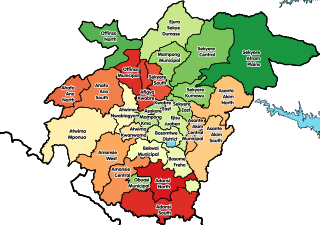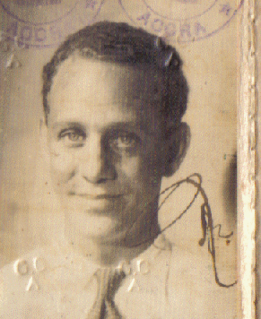Related Research Articles

Highlife is a music genre that started in present-day Ghana in the 19th century, during its history as a colony of the British Empire and through its trade routes in coastal areas. It describes multiple local fusions of African metre and western Jazz melodies. It uses the melodic and main rhythmic structures of traditional Akan music and Kpanlogo Music of the Ga people, but is typically played with Western instruments. Highlife is characterized by jazzy horns and multiple guitars which lead the band and its use of the two-finger plucking guitar style that is typical of African music. Recently it has acquired an uptempo, synth-driven sound.
There are many styles of traditional and modern music of Ghana, due to Ghana's worldwide geographic position on the African continent. The best known modern genre originating in Ghana is Highlife.So many years, Highlife was the preferred music genre until the introduction of Hiplife and many others.
Palm-wine music is a West African musical genre. It evolved among the Kru people of Liberia and Sierra Leone, who used Portuguese guitars brought by sailors, combining local melodies and rhythms with Trinidadian calypso to create a "light, easy, lilting style".

John Collins is a UK-born guitarist, harmonica player and percussionist who first went to Ghana as a child in 1952 for a brief period and later became involved in the West African music scene after returning to Ghana in 1969.

Offinso Municipal District is one of the forty-three districts in Ashanti Region, Ghana. Originally created as an ordinary district assembly in 1988 when it was known as Offinso District, which it was created from the former Offinso District Council; until the northern part of the district was later split off to create Offinso North District on 29 February 2008; while the remaining part was elevated to municipal district assembly status on the same year to become Offinso Municipal District. The municipality is located in the northern part of Ashanti Region and has Offinso as its capital town.
Articles related to Ghana include:
Philip Kwame Apagya is a Ghanaian photographer who specialises in colour studio portraits against painted backdrops. He lives and works in Shama, Ghana.

Koo Nimo, baptized Daniel Amponsah is a leading folk musician of Palm wine music or Highlife music from Ghana.

Beattie Casely-Hayford was a Ghanaian engineer. He was the first director of the Ghana Arts Council, a co-founder of the Ghana National Dance Ensemble, and a director of the Ghana Broadcasting Corporation (GBC).
Jay Ghartey, also known as Kweku Gyasi Ghartey, is a Ghanaian–American music producer, singer, and songwriter based in New York City, describing his style as African Rhythm and Blues. He released his debut album Shining Gold in 2011. He is most famous for the singles "My Lady" and "Papa". He is also the co-founder and co-owner of "GH Brothers", an independent record label and production company with his brother DJ and music producer Joe Ghartey.
The following is a timeline of the history of the city of Accra, Ghana.
Nana Kwame Ampadu was a Ghanaian musician credited with numerous popular highlife tracks and he is known to have composed over 800 songs. He was also known as Adwomtofo Nyinaa Hene.
Cabum, born Frank Kwame Gyasi- Frimpong on 15 June 1985, to Ghanaian highlife musician Alhaji Kwame Frimpong and Joyce Asabia Frimpong, is a Ghanaian rapper from Kumasi.
Jewel Ackah was a Ghanaian highlife and gospel musician. He composed the lyrics of "Arise Arise," the party anthem of the centre-left Ghanaian political party, the National Democratic Congress (NDC), popularly sung to the tune of the Christian hymn, "Stand Up, Stand Up for Jesus." He was dubbed by media pundits as the "Prince of Highlife".
Nana Kwame Akuoko Sarpong, is a traditional ruler, a politician and a lawyer. He is the paramount chief or Omanhene of the Agogo Traditional Area of Ghana. He served as Secretary for Health, Secretary for Internal Affairs and Secretary for Chieftaincy Affairs in the PNDC government. He also served as a member of the council of state in the fourth Republic.
Edward Kofi Donkor (1942–1995) was a Ghanaian highlife musician. He was popularly referred to as Senior Eddie Donkor or Eddie Donkor Senior.
Cape Coast Sugar Babies was one of the first highlife orchestras from Cape Coast.They were also known as the Light Orchestra. Their style of music is known as West African Highlife music.
Ghanaian highlife emerged in the 1980s as a mixture of West African rhythms from Europe by Black people from south and North America.
Kwame Asare, best known as Jacob Sam, was the first to record Ghanaian highlife music and was the first highlife guitarist.
Ghana's concert party theater is a known traveling theater performing in rural and urban cities with itinerant actors staging vernacular shows and a tradition of the twentieth century in West Africa.
References
- Citations
- ↑ Sarpong 2004, p. 456.
- ↑ "Gramophone Museum Established At Cape Coast". Accra Daily Mail . 3 April 2003.
- ↑ "Ghana Collections in the Archive of Folk Culture". Library of Congress. Retrieved 28 February 2014.
- Bibliography
- Sarpong, Kwame (2004). "Ghana's Highlife Music: A Digital Repertoire of Recordings and Pop Art at the Gramophone Records Museum". History in Africa. 31: 455–461. doi:10.1017/s0361541300003612. JSTOR 4128540.